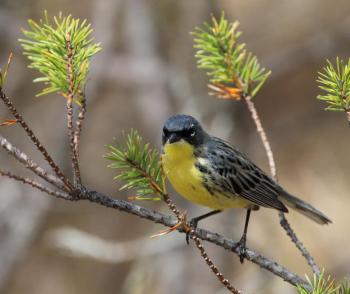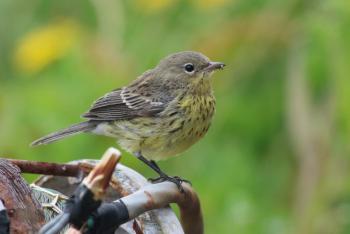North America’s Rarest Warbler Visits Maine
One of the rarest birds in North America has made an appearance in Maine! A Kirtland’s warbler was photographed on Matinicus Rock on Sept. 10. For us, the Kirtland’s warbler has always been almost mythical. Their northern Michigan breeding grounds are incredibly small. The population there reached a low of 167 males in 1974 and again in 1987.
As young birders, we desperately hoped that this special bird would not disappear from the face of the earth like the Bachman’s warbler had done, and that one day we would have a chance of seeing one.
Fortunately, the species was added to the official list of species protected by the Endangered Species Act such that science and resources were focused on finding ways to increase Kirtland’s warbler numbers. On the breeding grounds, the birds occur only in young jack pine forests that historically would have occurred after fires. Fire suppression resulted in fewer and fewer young jack pine stands, so Kirtland’s warblers became very habitat limited. Current management has focused on cutting down certain stands of jack pine when they become too old for the birds and replanting with young pines.
The birds were also hit hard by very high levels of brown-headed cowbird parasitism, greatly lowering the number of young Kirtland’s warblers that were fledged. Trapping and removal of the cowbirds dropped the numbers of them and boosted the reproductive success of the warblers.
All of these efforts brought the numbers steadily up so that there were more than 2,200 pairs estimated in 2021! The breeding range has also expanded so there are small numbers now nesting in Wisconsin and southern Ontario, thanks to habitat creation and enhancement efforts in those areas as well.
That’s one of the great success stories of conservation and certainly of the Endangered Species Act here in the U.S.
Still, the Kirtland’s warbler is the rarest North American warbler species (and one of the rarest birds overall). While it remains on our bucket list to see a Kirtland’s, we are comforted in the knowledge that seeing and hearing one is now quite easy to do with a visit to the Michigan breeding grounds in June.
The exact location of the wintering grounds and the habitat preferences of Kirtland’s warblers had remained quite elusive. They were known to occur generally in the Bahamas and thought to use Caribbean pine forests, but sightings of the species were few and far between. Then researchers began implementing new techniques like using sound recordings to lure the species into the open and later tracking the birds from the breeding grounds using geolocator technology. These new tools showed that Kirtland’s warblers preferred scrubby habitat on the wintering grounds rather than mature Caribbean pine forests, and that the bulk of the population occurred in the central Bahamian archipelago.
Kirtland’s warblers have a rather distinction plumage—bluish-gray backs and yellow bellies—and give a loud, cheerful song.
Maine’s first record of Kirtland’s warbler was a singing male that was heard and seen (and photographed) on June 2, 2008, by someone doing snake surveys in the pitch pines bordering the open land of the Kennebunk Plains Preserve. This second record appears to be a young bird, hatched just this past summer. Perhaps it had been on its way to the Bahamas when it got caught up in or pushed off course by Hurricane Idalia? Or maybe it just got off track on its own.
Either way, the fact that there are now enough Kirtland’s warblers in the world that two of these special and rare birds could have made their way to Maine is a testament to the amazing success of the Endangered Species Act and the thousands of people who have worked so hard to bring the species back from the brink of extinction.
Jeffrey V. Wells, Ph.D., is a Fellow of the Cornell Lab of Ornithology and Vice President of Boreal Conservation for National Audubon. Dr. Wells is one of the nation's leading bird experts and conservation biologists. He is a coauthor of the seminal “Birds of Maine” book and author of the “Birder’s Conservation Handbook.” His grandfather, the late John Chase, was a columnist for the Boothbay Register for many years. Allison Childs Wells, formerly of the Cornell Lab of Ornithology, is Senior Director of Communications at the Natural Resources Council of Maine, a nonprofit membership organization working statewide to protect the nature of Maine. Both are widely published natural history writers and are the authors of the popular books, “Maine’s Favorite Birds” (Tilbury House) and “Birds of Aruba, Bonaire, and Curaçao: A Site and Field Guide,” (Cornell University Press).






























